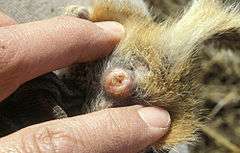Mating plug

A mating plug, also known as a copulation plug, sperm plug, vaginal plug, sement or sphragis, is gelatinous secretion used in the mating of some species. It is deposited by a male into a female genital tract, such as the vagina, and later hardens into a plug or glues the tract together.[1] While females can expel the plugs, the male’s sperm still gets a time advantage in getting to the egg, which is often the deciding factor in fertilization.
The mating plug plays an important role in sperm competition and may serve as an alternative and more advantageous strategy to active mate guarding. In some species, such a passive mate-guarding strategy may reduce selection on large male size.[2] Such a strategy may be advantageous because it would allow a male to increase reproductive success by spending more time pursuing new female mates rather than active mate-guarding.[2]
Composition
.jpg)
The mating plug of the Bombus terrestris was chemically analyzed and found to consist of palmitic acid, linoleic acid, oleic acid, stearic acid, and cycloprolylproline.[3] It was found that the acids (without cycloprolylproline) were sufficient by themselves to create the plug. Researchers hypothesize that cycloprolylproline reduces female receptivity to further breeding.
Occurrence in nature
Mating plugs are used by many species, including several primates,[2] kangaroos,[4] bees,[5] rats, reptiles, squirrels,[6] scorpions,[7] mice,[8] and spiders.[9]
Use of a mating plug as a strategy for reproductive success can also be seen in a few taxa of Lepidoptera and other insects and is often associated with pupal mating.[10] For example, male Variable Checkerspot butterflies pass a mating plug into the genital opening of females in order to prevent the females from remating and thus protecting their paternity.[11]
Heliconius charithonia uses a mating plug in the form of a spermataphore that provides predatory defense chemicals and protein sources for developing eggs.[12] It also acts as an anaphrodisiac that prevents other males from mating with the female.[13]
Most species of stingless bees, like Plebeia remota, are only mated once, and thus make use of mating plugs to store all the sperm they collect for future use.[5]
In homosexual matings
Male-male matings have been observed in species of acanthocephalan worms. Upon completion of the act, the penetrating partner will seal off the recipient's genital region with a mating plug.[14] Once sealed, the anal cavity becomes impervious to further infiltration.
See also
References
- ↑ David Quammen. The Flight of the Iguana: A Sidelong View of Science and Nature. Simon and Schuster, 1998, ISBN 0-684-83626-2. Page 29.
- 1 2 3 Dunham, A. E. & Rudolf, V. H. W. (2009). "Evolution of sexual size monomorphism: the influence of passive mate guarding". Journal of Evolutionary Biology. 22 (7): 1376–1386. doi:10.1111/j.1420-9101.2009.01768.x. PMID 19486235.
- ↑ Baer, Boris; Maile, Roland; Schmid-Hempel, Paul; Morgan, E. David; Jones, Graeme R. (2000). Journal of Chemical Ecology. 26 (8): 1869. doi:10.1023/A:1005596707591. Missing or empty
|title=(help) - ↑ Terence Dawson (16 April 2012). Kangaroos. Csiro Publishing. ISBN 978-0-643-10627-7. Retrieved 13 July 2013.
- 1 2 Strassmann, J. (2001-03-01). "The rarity of multiple mating by females in the social Hymenoptera". Insectes Sociaux. 48 (1): 1–13. doi:10.1007/PL00001737. ISSN 0020-1812.
- ↑ Vaginal plug. Biology online dictionary
- ↑ Contreras-Garduno, Jorge; Peretti, Alfredo V.; Cordoba-Aguilar, Alex (2006). "Evidence that Mating Plug is Related to Null Female Mating Activity in the Scorpion Vaejovis punctatus". Ethology. 112 (2): 152. doi:10.1111/j.1439-0310.2006.01149.x.
- ↑ Ittner, Lars M; Götz, Jürgen (2007). "Pronuclear injection for the production of transgenic mice". Nature Protocols. 2 (5): 1206–15. doi:10.1038/nprot.2007.145. PMID 17546016. Figure 2 - Mating scheme and copulation plug
- ↑ Knoflach, B. & van Harten, A. (2001). "Tidarren argo sp. nov (Araneae: Theridiidae) and its exceptional copulatory behaviour: emasculation, male palpal organ as a mating plug and sexual cannibalism". Journal of Zoology. 254 (4): 449–459. doi:10.1017/S0952836901000954.
- ↑ The encyclopedia of land invertebrate behaviour By Rod Preston-Mafham, Ken Preston-Mafham. Pg 113.
- ↑ Dickinson, Janis L.; Rutowski, Ronald L. (1989). "The Function of the Mating Plug in the Chalcedon Checkerspot Butterfly". Animal Behaviour. 38 (1): 154–62. doi:10.1016/s0003-3472(89)80074-0.
- ↑ Cardoso, Márcio Zikán; Gilbert, Lawrence E. (2006). "A Male Gift to Its Partner? Cyanogenic Glycosides in the Spermatophore of Longwing Butterflies (Heliconius)". Naturwissenschaften. 94 (1): 39–42. doi:10.1007/s00114-006-0154-6.
- ↑ Estrada, Catalina; Schulz, Stefan; Yildizhan, Selma; Gilbert, Lawrence E. (2011). "Sexual Selection Drives The Evolution Of Antiaphrodisiac Pheromones In Butterflies". Evolution. 65 (10): 2843–854. doi:10.1111/j.1558-5646.2011.01352.x.
- ↑ Abele, L.; Gilchrist, S (1977). "Homosexual rape and sexual selection in acanthocephalan worms". Science. 197 (4298): 81–3. doi:10.1126/science.867055. PMID 867055.